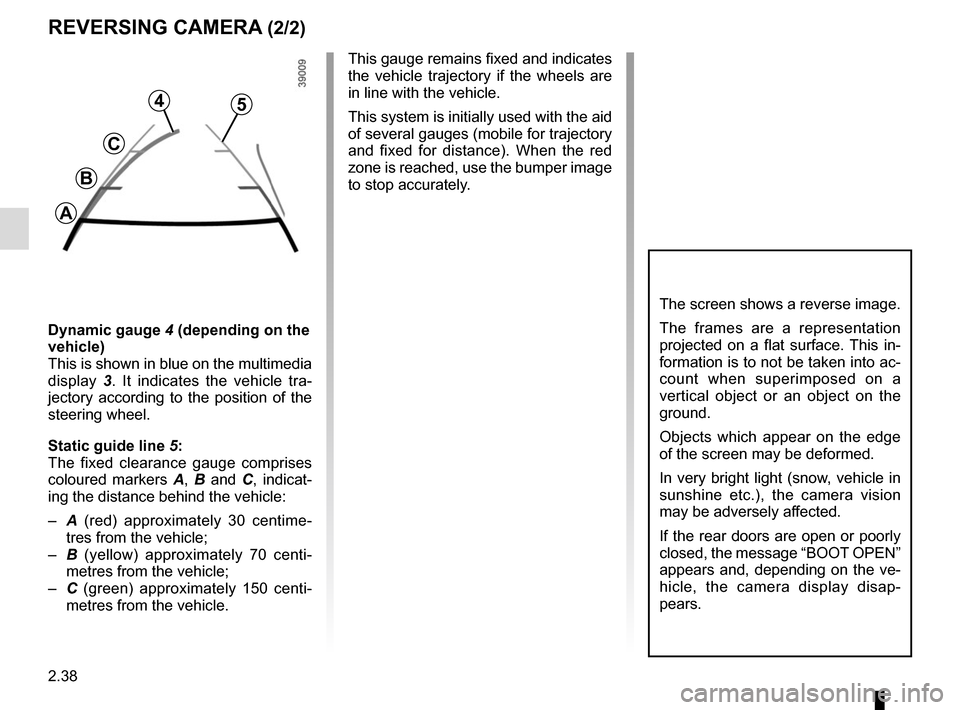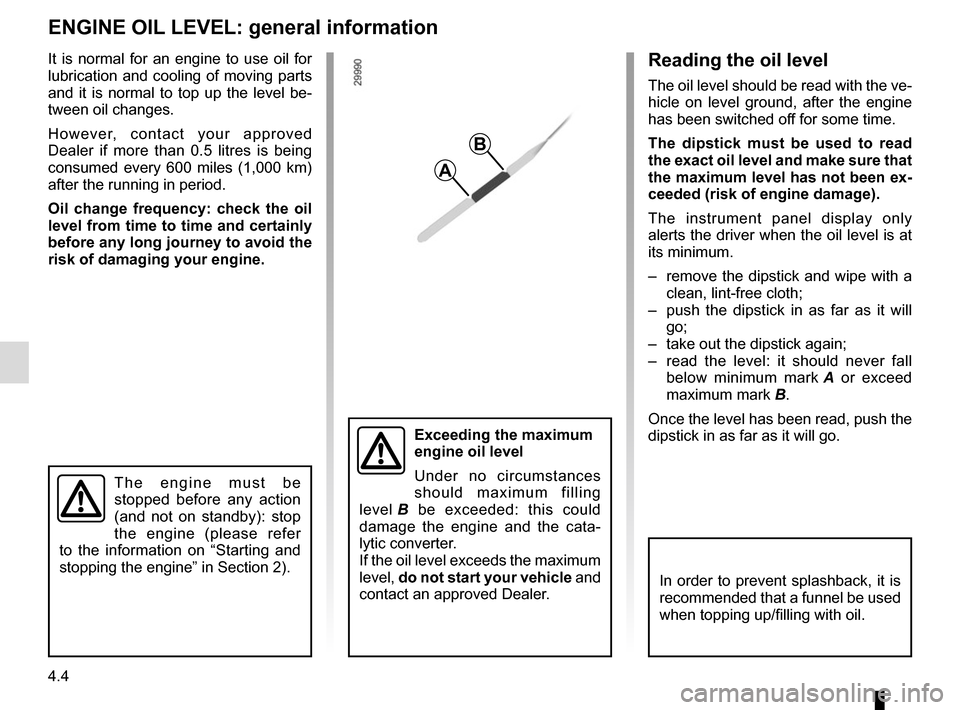display RENAULT TRAFIC 2017 X82 / 3.G Owner's Guide
[x] Cancel search | Manufacturer: RENAULT, Model Year: 2017, Model line: TRAFIC, Model: RENAULT TRAFIC 2017 X82 / 3.GPages: 294, PDF Size: 7.94 MB
Page 163 of 294

2.37
REVERSING CAMERA (1/2)
Operation
Moving into reverse gear, the camera 1
located on the tailgate or, depending
on the vehicle, on the rear hinged door,
provides a view of the area behind the
vehicle on the rear-view mirror 2 or, de-
pending on the vehicle, on the multi-
media display 3, accompanied by two
moving or fixed guide lines 4 and 5.
1
Note: make sure that the reversing
camera is not obscured (by dirt, mud,
snow, condensation, etc.).
3
Note: depending on the vehicle, you
can adjust certain settings from the
multimedia display 3. Refer to the
handbook for the equipment.
This function is an additional aid. It cannot, therefore, under any circ\
um-
stances replace the vigilance or the responsibility of the driver.
The driver should always be ready for sudden incidents while driving:
always ensure that there are no small, narrow moving obstacles (such
as a child, animal, pushchair, bicycle, stone, post, etc.) in the blind spot when
manoeuvring.
2
Page 164 of 294

2.38
REVERSING CAMERA (2/2)
The screen shows a reverse image.
The frames are a representation
projected on a flat surface. This in-
formation is to not be taken into ac-
count when superimposed on a
vertical object or an object on the
ground.
Objects which appear on the edge
of the screen may be deformed.
In very bright light (snow, vehicle in
sunshine etc.), the camera vision
may be adversely affected.
If the rear doors are open or poorly
closed, the message “BOOT OPEN”
appears and, depending on the ve-
hicle, the camera display disap-
pears.
Dynamic gauge 4 (depending on the
vehicle)
This is shown in blue on the multimedia
display 3. It indicates the vehicle tra-
jectory according to the position of the
steering wheel.
Static guide line 5:
The fixed clearance gauge comprises
coloured markers A, B and C , indicat-
ing the distance behind the vehicle:
– A (red) approximately 30 centime-
tres from the vehicle;
– B (yellow) approximately 70 centi-
metres from the vehicle;
– C (green) approximately 150 centi-
metres from the vehicle. This gauge remains fixed and indicates
the vehicle trajectory if the wheels are
in line with the vehicle.
This system is initially used with the aid
of several gauges (mobile for trajectory
and fixed for distance). When the red
zone is reached, use the bumper image
to stop accurately.
4
C
B
A
5
Page 210 of 294

4.4
It is normal for an engine to use oil for
lubrication and cooling of moving parts
and it is normal to top up the level be-
tween oil changes.
However, contact your approved
Dealer if more than 0.5 litres is being
consumed every 600 miles (1,000 km)
after the running in period.
Oil change frequency: check the oil
level from time to time and certainly
before any long journey to avoid the
risk of damaging your engine.
ENGINE OIL LEVEL: general information
Exceeding the maximum
engine oil level
Under no circumstances
should maximum filling
level B be exceeded: this could
damage the engine and the cata-
lytic converter.
If the oil level exceeds the maximum
level, do not start your vehicle and
contact an approved Dealer.
In order to prevent splashback, it is
recommended that a funnel be used
when topping up/filling with oil.
Reading the oil level
The oil level should be read with the ve-
hicle on level ground, after the engine
has been switched off for some time.
The dipstick must be used to read
the exact oil level and make sure that
the maximum level has not been ex-
ceeded (risk of engine damage).
The instrument panel display only
alerts the driver when the oil level is at
its minimum.
– remove the dipstick and wipe with a clean, lint-free cloth;
– push the dipstick in as far as it will go;
– take out the dipstick again;
– read the level: it should never fall below minimum mark A or exceed
maximum mark B.
Once the level has been read, push the
dipstick in as far as it will go.
A
B
The engine must be
stopped before any action
(and not on standby): stop
the engine (please refer
to the information on “Starting and
stopping the engine” in Section 2).
Page 221 of 294

4.15
Glass instrument panel(e.g.: instrument panel, clock, exterior
temperature display, radio display, mul-
timedia or multifunction display etc.)
Use a soft cloth (or cotton wool).
If this does not clean them properly,
use a soft cloth (or cotton wool) slightly
moistened with soapy water and then
wipe clean with another soft damp cloth
or cotton wool.
Finally, carefully dry off with a soft dry
cloth.
Do not use products containing alco-
hol and/or spray fluids on the area.
Seat belts
These must be kept clean.
Use products selected by our Technical
Department (Approved outlets) or
warm, soapy water and a sponge and
wipe with a dry cloth.
Detergents or dyes must not be used
under any circumstances.
INTERIOR TRIM MAINTENANCE (1/2)
Textiles (seats, door trim, etc)
Vacuum-clean the textiles regularly.
Liquid stain
Use soapy water.
Dab lightly (never rub) with a soft cloth,
rinse and remove the excess.
Solid or pasty stain
Carefully remove the excess solid or
pasty material immediately with a
spatula (working from the edges to the
centre to avoid spreading the stain).
Clean as for a liquid stain.
Special instructions for sweets or
chewing gum
Put an ice cube on the stain to solidify
it, then proceed as for a solid stain.
A well-maintained vehicle will last
longer. It is therefore recommended to
maintain the interior of the vehicle regu-
larly.
A stain should always be dealt with
swiftly.
Whatever type of stain is on the trim,
use
cold (or warm) soapy water with
natural soap.
Detergents (washing-up liquid, pow-
dered products, alcohol-based prod-
ucts) should not be used.
Use a soft cloth.
Rinse and soak up the excess.
For further recommendations for
maintaining the interior, and/or for
any unsatisfactory results, please
see an authorised dealer.
Page 287 of 294

7.1
ALPHABETICAL INDEX (1/5)
A
ABS ..............................................................1.86, 2.21 → 2.25
accessories........................................................................\
5.30
accessories socket ................................................. 3.29 – 3.30
AdBlue ............................................................... 1.116 → 1.119
AdBlue additive.................................................. 1.116 → 1.119
additional methods of restraint .......................................... 1.43 side protection ............................................................. 1.42
to the front seat belts .......................................1.37 → 1.40
to the rear seat belts .................................................... 1.41
additive (tank) .................................................... 1.116 → 1.119
additive tank ...................................................... 1.116 → 1.119
adjusting your driving position ..1.28 – 1.30, 1.32 → 1.36, 3.31
advice on antipollution ....................................................... 2.16
air bag.......................................1.37 → 1.40, 1.42 – 1.43, 1.84
activating the front passenger air bags ........................ 1.79
deactivating the front passenger air bags .................... 1.77
air conditioning ........................................................3.4 → 3.14
air vents ...................................................................... 3.2 – 3.3
anti-corrosion check ..............................................6.18 → 6.22
anti-corrosion protection .................................................... 4.13
anti-lock braking system: ABS ...............................2.21 → 2.25
antipollution advice .................................................................\
......... 2.16
armrest: front ..................................................................\
............ 3.24
ashtray .................................................................... 3.29 – 3.30
audible and visual signals................................................ 1.109
B
battery............................................................ 4.12, 5.24 – 5.25 troubleshooting ................................................. 5.24 – 5.25
bonnet........................................................................\
. 4.2 – 4.3
brake fluid ........................................................................\
.... 4.8
bulbs changing ..........................................................5.14 → 5.21C
catalytic converter.............................................................. 2.10
central door locking 1.4 → 1.6, 1.13, 1.16 → 1.21, 1.23 → 1.27
changing a bulb .....................................................5.14 → 5.21
changing a wheel...................................................... 5.9 – 5.10
changing gear .................................................................... 2.11
child restraint/seat ....................1.44 – 1.45, 1.47 → 1.64, 1.77
child safety......1.15, 1.40, 1.44 – 1.45, 1.47 → 1.64, 1.77, 2.4,
3.15 – 3.16
child seats..........................................1.44 – 1.45, 1.47 → 1.64
children ................................. 1.2, 1.7, 1.44 – 1.45, 3.15 – 3.16
children (safety) ................................................... 1.2, 1.7, 1.15
cigar lighter ............................................................. 3.29 – 3.30
cleaning: inside the vehicle .............................................. 4.15 – 4.16
clock ..................................................................... 1.99 – 1.100
closing the doors ........................................... 1.14 – 1.15, 1.27
control instruments ..........................1.84 → 1.91, 1.99 – 1.100
controls ...............................................................\
...1.80 → 1.83
courtesy light ................................................. 3.18 – 3.19, 5.20
cruise control ................................................1.87, 2.29 → 2.32
cruise control-speed limiter....................................2.26 → 2.32
D
dashboard..............................................................1.80 → 1.83
deadlocking the doors ................................................ 1.6, 1.13
demisting rear screen ......................................................... 3.8 → 3.11
windscreen .................................................. 3.5, 3.8 → 3.11
dimensions .............................................................\
...6.4 → 6.7
dipstick................................................................\
................. 4.4
display ................................................................\
...1.84 →
1.89
doors......................................................................1.18 →
1.21
doors/tailgate .......................1.2 → 1.8, 1.13, 1.23 – 1.24, 1.27
driver’s position .....................................................1.80 → 1.87
driving ............ 2.2 → 2.6, 2.10, 2.14, 2.18 → 2.33, 2.35 – 2.36